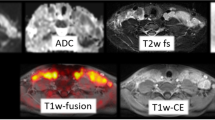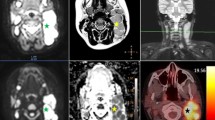Abstract
Background
Accurate assessment of splenic disease is important for staging Hodgkin lymphoma.
Objective
The purpose of this study was to assess T2-weighted imaging with and without dynamic contrast-enhanced (DCE) MRI for evaluation of splenic Hodgkin disease.
Materials and methods
Thirty-one children with Hodgkin lymphoma underwent whole-body T2-weighted MRI with supplementary DCE splenic imaging, and whole-body PET-CT before and following chemotherapy. Two experienced nuclear medicine physicians derived a PET-CT reference standard for splenic disease, augmented by follow-up imaging. Unaware of the PET-CT, two experienced radiologists independently evaluated MRI exercising a locked sequential read paradigm (T2-weighted then DCE review) and recorded the presence/absence of splenic disease at each stage. Performance of each radiologist was determined prior to and following review of DCE-MRI. Incorrect MRI findings were ascribed to reader (lesion present on MRI but missed by reader) or technical (lesion not present on MRI) error.
Results
Seven children had splenic disease. Sensitivity/specificity of both radiologists for the detection of splenic involvement using T2-weighted images alone was 57%/100% and increased to 100%/100% with DCE-MRI. There were three instances of technical error on T2-weighted imaging; all lesions were visible on DCE-MRI.
Conclusions
T2-weighted imaging when complemented by DCE-MRI imaging may improve evaluation of Hodgkin disease splenic involvement.







Similar content being viewed by others
References
Chavhan GB, Babyn PS (2011) Whole-body MR imaging in children: principles, technique, current applications, and future directions. Radiographics 31:1757–1772
Rueffer U, Sieber M, Stemberg M et al (2003) Spleen involvement in Hodgkin’s lymphoma: assessment and risk profile. Ann Hematol 82:390–396
Pendlebury SC, Boyages S, Koutts J et al (1992) Thymic hyperplasia associated with Hodgkin disease and thyrotoxicosis. Cancer 70:1985–1987
Rathore B, Kadin ME (2010) Hodgkin’s lymphoma therapy: past, present, and future. Expert Opin Pharmacother 11:2891–2906
Abdulqadhr G, Molin D, Astrom G et al (2011) Whole-body diffusion-weighted imaging compared with FDG-PET/CT in staging of lymphoma patients. Acta Radiol 52:173–180
Kwee TC, van Ufford HM, Beek FJ et al (2009) Whole-body MRI, including diffusion-weighted imaging, for the initial staging of malignant lymphoma: comparison to computed tomography. Invest Radiol 44:683–690
van Ufford HM, Kwee TC, Beek FJ et al (2011) Newly diagnosed lymphoma: initial results with whole-body T1-weighted, STIR, and diffusion-weighted MRI compared with 18F-FDG PET/CT. AJR Am J Roentgenol 196:662–669
Punwani S, Taylor SA, Bainbridge A et al (2010) Pediatric and adolescent lymphoma: comparison of whole-body STIR half-Fourier RARE MR imaging with an enhanced PET/CT reference for initial staging. Radiology 255:182–190
Mauch PM (1994) Controversies in the management of early stage Hodgkin’s disease. Blood 83:318–329
Bhatia K, Sahdev A, Reznek RH (2007) Lymphoma of the spleen. Semin Ultrasound CT MR 28:12–20
Huang B, Law MW, Khong PL (2009) Whole-body PET/CT scanning: estimation of radiation dose and cancer risk. Radiology 251:166–174
Brenner D, Elliston C, Hall E et al (2001) Estimated risks of radiation-induced fatal cancer from pediatric CT. AJR Am J Roentgenol 176:289–296
Kleinerman RA (2006) Cancer risks following diagnostic and therapeutic radiation exposure in children. Pediatr Radiol 36:121–125
Kleis M, Daldrup-Link H, Matthay K et al (2009) Diagnostic value of PET/CT for the staging and restaging of pediatric tumors. Eur J Nucl Med Mol Imaging 36:23–36
Mirowitz SA, Brown JJ, Lee JK et al (1991) Dynamic gadolinium-enhanced MR imaging of the spleen: normal enhancement patterns and evaluation of splenic lesions. Radiology 179:681–686
Landis JR, Koch GG (1977) An application of hierarchical kappa-type statistics in the assessment of majority agreement among multiple observers. Biometrics 33:363–374
Bossuyt PM, Reitsma JB, Bruns DE et al (2003) Toward complete and accurate reporting of studies of diagnostic accuracy: the STARD initiative. Acad Radiol 10:664–669
de Jong PA, van Ufford HM, Baarsiag HJ et al (2009) CT and 18F-FDG PET for noninvasive detection of splenic involvement in patients with malignant lymphoma. AJR Am J Roentgenol 192:745–753
Hoane BR, Shields AF, Porter BA et al (1994) Comparison of initial lymphoma staging using computed tomography (CT) and magnetic resonance (MR) imaging. Am J Hematol 47:100–105
Kellenberger CJ, Epelman M, Miller SF et al (2004) Fast STIR whole-body MR imaging in children. Radiographics 24:1317–1330
Runge VM, Williams NM (1998) Dynamic contrast-enhanced magnetic resonance imaging in a model of splenic metastasis. Invest Radiol 33:45–50
Chang WC, Liou CH, Kao HW et al (2007) Solitary lymphangioma of the spleen: dynamic MR findings with pathological correlation. Br J Radiol 80:e4–e6
Elsayes KM, Narra VR, Mukundan G et al (2005) MR imaging of the spleen: spectrum of abnormalities. Radiographics 25:967–982
Hernandez-Maraver D, Hernandez-Navarro F, Gomez-Leon N et al (2006) Positron emission tomography/computed tomography: diagnostic accuracy in lymphoma. Br J Haematol 135:293–302
Rini JN, Leonidas JC, Tomas MB et al (2003) 18F-FDG PET versus CT for evaluating the spleen during initial staging of lymphoma. J Nucl Med 44:1072–1074
Rini JN, Manalili EY, Hoffman MA et al (2002) F-18 FDG versus Ga-67 for detecting splenic involvement in Hodgkin’s disease. Clin Nucl Med 27:572–577
Lister TA, Crowther D, Sutcliffe SB et al (1989) Report of a committee convened to discuss the evaluation and staging of patients with Hodgkin’s disease: Cotswolds meeting. J Clin Oncol 7:1630–1636
Acknowledgments
This work was undertaken at the Comprehensive Biomedical Centre, University College Hospital London, which received a proportion of the funding from the National Institute for Health Research. The views expressed in this publication are those of the authors and not necessarily those of the UK Department of Health. The authors are grateful to the Royal College of Radiologists and the Radiological Research Trust for grants in support of this work.
Author information
Authors and Affiliations
Corresponding author
Rights and permissions
About this article
Cite this article
Punwani, S., Cheung, K.K., Skipper, N. et al. Dynamic contrast-enhanced MRI improves accuracy for detecting focal splenic involvement in children and adolescents with Hodgkin disease. Pediatr Radiol 43, 941–949 (2013). https://doi.org/10.1007/s00247-012-2616-7
Received:
Revised:
Accepted:
Published:
Issue Date:
DOI: https://doi.org/10.1007/s00247-012-2616-7




